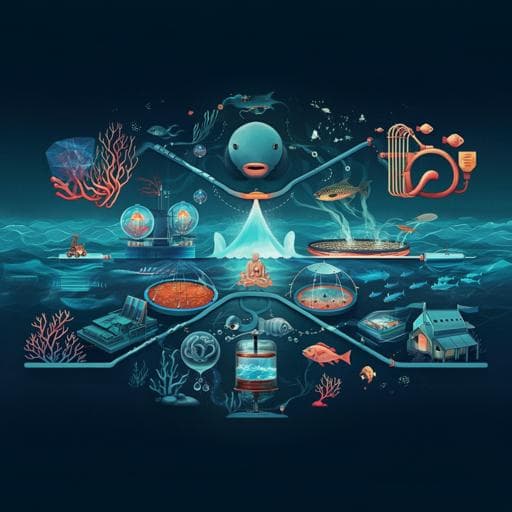
Environmental Studies and Forestry
Two decades of research on ocean multi-use: achievements, challenges and the need for transdisciplinarity
J. Guyot-téphany, B. Trouillet, et al.
Dive into the fascinating exploration of ocean multi-use research led by a team of experts including Josselin Guyot-Téphany and Brice Trouillet. This paper reveals the intricate social, geographical, and conceptual dimensions of scientific production in this area and highlights crucial research gaps that call for transdisciplinary approaches.
~3 min • Beginner • English
Introduction
The concept of ocean multi-use (MU) emerged from early-2000s research proposing synergies such as integrating aquaculture with offshore wind farms in the North Sea. In the 2010s, the European Commission incorporated MU into the Blue Growth Strategy, funding applied research to foster synergies among maritime industries, mitigate space/resource conflicts, and reduce environmental pressures. As the term broadened to encompass many functional, spatial, and temporal interactions (e.g., wind–wave integration, repurposed oil platforms, pescatourism), definitions proliferated (e.g., multi-use of space vs. multi-use platforms; hard vs. soft MU). Despite enthusiasm, few operational “win–win” combinations exist due to regulatory hurdles, immature technologies/business models, limited stakeholder willingness, and uncertainties about ecological and cumulative impacts. Recognizing MU largely remains theoretical, this study asks: Why and how did MU become a popular policy concept? How does it compare with MPAs and MSP? How can it be transposed beyond Europe? And how can science, policy, and society be better integrated? A bibliometric analysis is conducted to address these questions.
Literature Review
The review situates MU within a longer tradition of managing coexisting marine uses. The broader notion of “multiple use” traces to mid-20th century forestry (codified in the U.S. Multiple Use Sustained Yield Act of 1960) and migrated to marine contexts in the 1970s–1980s to address crowding, conflicts, and resource impacts, spurring calls for planning and zonation—especially within MPAs and later MSP. The large corpus (311 Scopus-indexed documents, 1970–2020) mainly concerns multiple-use MPAs and MSP, whereas a shorter, more recent corpus focuses on synergy-based MU in the European sense (68 documents). Early MU-in-the-narrow-sense work originated with German research on integrating aquaculture and wind farms; parallel Portuguese work explored multifunctional artificial reefs. EU policy (Blue Growth) and funding (FP7, Horizon 2020, Interreg) strongly shaped MU’s trajectory, emphasizing synergies and economic growth and supporting both multi-use platforms and co-located activity synergies (e.g., MUSES project’s 17 combinations). Co-authorship networks and keyword co-occurrence reveal distinct clusters: MPA-focused groups (e.g., governance, zonation, participation, socio-economic effects) and MU-focused European consortia (offshore energy, aquaculture, multi-purpose platforms, artificial reefs). The keyword networks center on “MPA”, with a separate MU cluster linked to aquaculture, offshore wind, MSP, and Blue Growth. Overall, MU is newer, niche, and EU-driven, with limited cross-fertilization with global MPA research communities.
Methodology
A bibliometric approach was used to analyze scientific production on MU. Data source: Scopus, chosen for accessibility and reliable coverage compared to Google Scholar, acknowledging underrepresentation of pre-2000, social science, and non-anglophone outputs relative to Web of Science. Search fields: titles, abstracts, and keywords. Query: ("multi-use" OR "multiple uses" OR "multifunctional use" OR "co-use") AND ("ocean" OR "sea" OR "marine" OR "maritime" OR "coastal"). Exclusions: conference papers, notes, unclassified publications. Time span: 1970–2020. Results: 1,700 documents retrieved; after comprehensive individual review, 1,389 excluded for focusing on terrestrial topics, unrelated subjects, or treating marine uses in isolation, yielding a large collection of 311 documents. From this, synergy-based MU papers (European understanding) were extracted to form a short collection of 68 documents. Analyses employed the Bibliometrix R package and its Biblioshiny interface to compute indicators (publication year, authorship patterns, countries), and to map social structures (co-authorship networks; normalization = association; layout = Fruchterman–Reingold; Louvain clustering) and conceptual structures (author keyword co-occurrence networks; same parameters). Quantitative results were complemented by qualitative examination of influential papers, especially from the short collection. Data underlying the analysis are openly available (https://doi.org/10.5281/zenodo.7875438).
Key Findings
- Field evolution: Multiple-use research dates to the 1970s, accelerating post-2010, largely via MPAs/MSP; synergy-based MU (European sense) is more recent, growing rapidly after 2015 from origins in offshore wind–aquaculture integration and multifunctional artificial reefs.
- Corpus composition: 1,700 initial items (1970–2020) → 311 large collection; short collection of 68 synergy-based MU documents.
- Collaboration patterns: Short collection is highly collaborative (96% multi-authored; mean 5.2 co-authors/doc) vs. large collection (76%; mean 3.8). MU research is driven by a few highly productive authors and EU-funded consortia.
- Social structure: Eight clusters identified; four centered on MPAs (international classification; national groups on socio-political issues, socio-economic effects, participation) and four on MU (co-located uses, multi-purpose platforms, European consortia; a smaller cluster on Portuguese artificial reefs). Limited collaboration between MU specialists and global MPA communities.
- Conceptual structure: In the large collection, “MPA” is the central keyword tied to marine conservation, fisheries (small-scale), governance, management, planning, and zonation tools (GIS, Marxan). MU-related keywords form a distinct cluster linked to MSP, aquaculture, offshore wind, marine renewables, and Blue Growth, reflecting an economic/synergy orientation rather than conservation objectives.
- Policy shaping: MU’s emergence and diffusion are closely tied to EU Blue Growth agendas and funding, emphasizing synergies among maritime industries (notably renewables and aquaculture).
- Implementation gap: Despite conceptual appeal, operational “win–win” MU cases are few due to stakeholder awareness/willingness issues, regulatory and permitting hurdles, immature technologies and business models (esp. hard MU), and limited knowledge of ecological/cumulative effects.
- Positioning vs MPAs/MSP: MU aims at higher integration levels (cooperation/integration of uses via technical/design/management solutions), whereas MPAs/MSP often emphasize coexistence/regulation via spatial processes; MSP increasingly also seeks synergies.
Discussion
Placing MU within the broader tradition of MPA and MSP research highlights shared transdisciplinary challenges. The paper frames integration along three dimensions: (1) relationships among marine uses—from coexistence and interactions to cooperation and full integration; MU aspires to the higher end (functional integration), whereas MPAs/MSP more often regulate coexistence (though MSP is moving toward synergy identification); (2) scientific regime—from disciplinary to transdisciplinary; MU, by nature, requires transdisciplinarity but practice remains largely multidisciplinary and dominated by natural/engineering sciences, with social sciences often reduced to methods; environmental topics like cumulative impacts remain underexplored; (3) science–policy–society interface—from fundamental research to co-production/transdisciplinarity; MU has been propelled by EU policy/funding, leading to a post-science, solution-oriented posture that can overlook deeper political and social questions (e.g., power, equity, enclosures), with participation often top-down. The authors caution that MU’s industrial model risks reinforcing enclosure dynamics (ocean grabbing) if not critically examined. They argue for bridging MU with MPA/MSP communities to share insights on governance, participation, and ecosystem services, and for strengthening both social science engagement (power, participation, cultural values) and natural science assessments (cumulative impacts) to align MU with sustainability science.
Conclusion
Ocean multi-use has rapidly gained traction, especially in Europe, reframing marine management discourse toward functional synergies and economic growth. While continuous with MPA/MSP traditions, MU is distinctive in its integration ambitions and Blue Growth orientation. Yet, practical translation remains limited, underscoring its largely theoretical status compared to the more concrete track records of MPAs and MSP. The concept’s spread coincides with offshore renewables and aquaculture expansion, reshaping policy and research agendas. Advancing MU requires: (i) stronger bridges across disciplines (toward true transdisciplinarity) and between MU and MPA/MSP communities; (ii) expanded social science engagement on participation, power, and values; (iii) deeper natural science inquiry into cumulative ecological impacts; and (iv) reflexive, critical approaches that scrutinize MU’s rationale and implications to better align objectivity with normativity and science with action.
Limitations
- Database and coverage: Reliance on Scopus, which tends to underrepresent pre-2000 publications, social science perspectives, and non-anglophone journals compared to Web of Science; potential omissions or biases in the corpus.
- Time window and document types: Analysis limited to 1970–2020 and to journal articles (excluding conferences, notes, unclassified items), possibly omitting relevant grey literature or recent outputs.
- Keyword-based retrieval: Dependence on titles/abstracts/keywords and manual screening may misclassify or exclude pertinent studies, especially those using different terminology.
- Generalizability: Bibliometric patterns capture publication structures and discourse but do not directly measure on-the-ground MU implementation outcomes.
Related Publications
Explore these studies to deepen your understanding of the subject.







